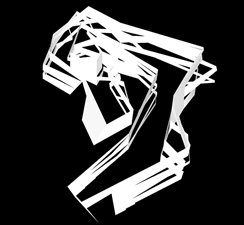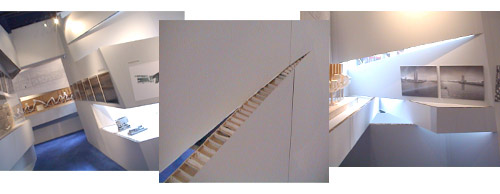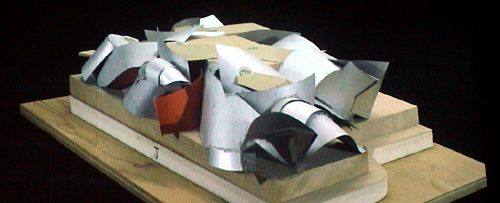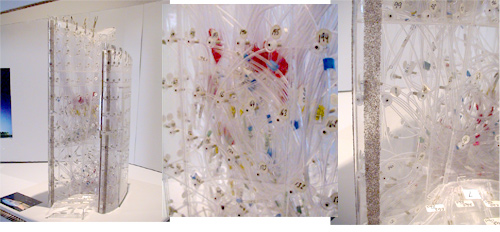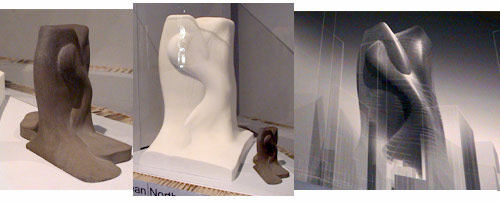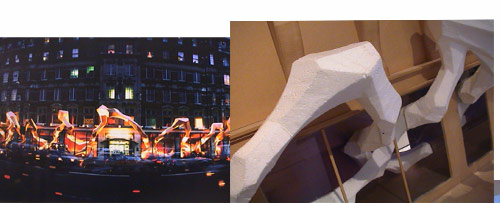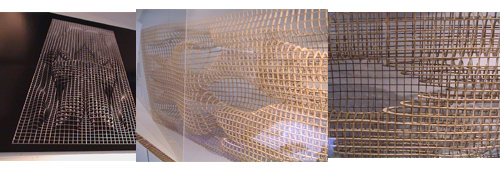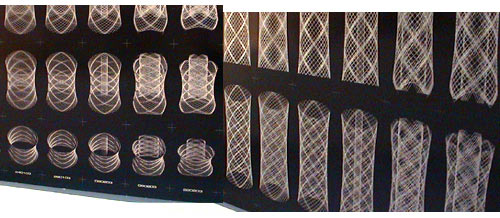 |


> archived articles > write for core! be famous!
|
Trial & Error -- Beyond Imagination
The Building Centre is a permanent exhibition space for building materials, fittings and furnishings, a kind of permanent trade show. A place where you are more likely to find the latest innovation in bricks and floor tiles than the working models of some of the most interesting designers, architects and engineers working today.
Until August 2, a small corner of the foyer is being inhabited by the angular installation cum exhibition space designed by Magma Architecture with engineers Buro Happold. Inside the folds and planes of this space--which echo the dynamic nature of the modelling process itself--the exhibition brings our attention to working models both physical and virtual from architectural practices throughout the world. They are described as the 'ghosts' of the design and development process--communication tools, experiments and prototypes often not meant to be seen outside of the project team itself. Ignorant of architectural rhetoric, Human Beans bring you our reading of the show.
We're told that the sculptural nature and complex geometry of contemporary architectural form necessitates more complex prototyping techniques and virtual 3D modeling (think Gehry's Guggenheim or Foster's Gherkin.) And since a craftsman is nothing without his tools, it's the existence of ever more powerful software and hardware which allows such complex forms to be realised. Architecture has traditionally looked enviously at the relative ease with which product designers can prototype their proposals, whilst they have been hampered by the complexity and expense of prototyping environments. As designers, we know how quickly a computer becomes an extension of ourselves and our creative process. Over recent years, architects too have embraced increasingly powerful technology to prototype their work--not only to test, validate and implement, but beyond that--to inspire.
At a functional level, engineers use virtual and physical models to test quantifiable factors. Arup Acoustics models sound as coloured ray-traced pixels to understand the acoustic performance of a theatre auditorium. Buro Happold created a 1:300 scale model of a 17 floor building and tested it in a wind tunnel to predict the stresses on the surfaces of the building. The beauty of the animated sound is mesmerising, and the complexity of the wind model, shown above, astounding.
3D-scanning technology and rapid prototyping have changed the relationship of the human hand to the building. Buildings sculpted at a scale of 1:300 can be scaled up to 30 floors with little loss of integrity. You can almost imagine the hand of the architect at 300 times scale, godlike, putting the finishing touches to his masterwork on the New York skyline.
Through digital scanning, Gehry turns a sheet of crumpled paper into a sheet of undulating steel. For his Autumn Intrusion installation, Thomas Heatherwick worked in polystyrene at a manageable scale before translating the form to architectural reality, in Birch aero-ply with a core of expanded polystyrene.
Digital technology can make the intangible tangible--Achim Menges' landscape for a Playhouse in Copenhagen was derived from a series of soap bubbles experiments. The twists and turns of the bubbles provided a diversity of performance spaces with differing conditions of exposure, climate, sound and light. Here the virtual form is realised in laser cut plywood.
So, for some, the computer offers the opportunity to explore and generate possibilities beyond imagination. Emergence Design Group use generative formulae to develop, through iteration, complex architectural forms that always maintain their structural integrity--the computer keeps "in mind" the constraints of the physical world. The results: great looking stuff you'd never come up with--and it works. Through digital modelling and prototyping, architects and engineers are stretching the experiential qualities of their buildings. More complex structures, more exacting control of environmental factors and daunting scales ultimately make the experience of the building richer and more fascinating for us all. --- Trial & Error; Working Models is on exhibition until August 2 at the Building Centre, London Human Beans live, design and write from their
home base of London. |
|
|
|
> back to top > back to core |
